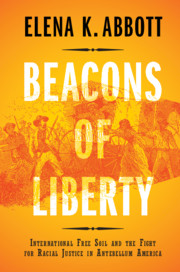Book contents
- Beacons of Liberty
- Beacons of Liberty
- Copyright page
- Contents
- List of Figures, Maps, and Tables
- Additional material
- Introduction
- Chapter 1 Reform and Relocation: West Africa and Haiti in the Early Republic
- Chapter 2 Exit and Expansion: The Search for Legal Equality in a Time of Crisis
- Chapter 3 Departure and Debate: Free Black Emigration to Canada and Mexico
- Chapter 4 Assessing Abolition: Investigating the Results of British Emancipation
- Chapter 5 Reputations and Expectations: Assessing Migrant Life in Upper Canada
- Chapter 6 Escape and Escalation: Self-Emancipation and the Geopolitics of Freedom
- Chapter 7 Free Soil, Fiction, and the Fugitive Slave Act
- Chapter 8 Emigration and Enmity: The Meaning of Free Soil in a Nation Divided
- Conclusion
- Acknowledgments
- Notes
- Bibliography
- Index
Chapter 2 - Exit and Expansion: The Search for Legal Equality in a Time of Crisis
Published online by Cambridge University Press: 09 April 2021
- Beacons of Liberty
- Beacons of Liberty
- Copyright page
- Contents
- List of Figures, Maps, and Tables
- Additional material
- Introduction
- Chapter 1 Reform and Relocation: West Africa and Haiti in the Early Republic
- Chapter 2 Exit and Expansion: The Search for Legal Equality in a Time of Crisis
- Chapter 3 Departure and Debate: Free Black Emigration to Canada and Mexico
- Chapter 4 Assessing Abolition: Investigating the Results of British Emancipation
- Chapter 5 Reputations and Expectations: Assessing Migrant Life in Upper Canada
- Chapter 6 Escape and Escalation: Self-Emancipation and the Geopolitics of Freedom
- Chapter 7 Free Soil, Fiction, and the Fugitive Slave Act
- Chapter 8 Emigration and Enmity: The Meaning of Free Soil in a Nation Divided
- Conclusion
- Acknowledgments
- Notes
- Bibliography
- Index
Summary
This chapter explores and explains the origins of the Underground Railroad to Canada. In 1830, Ohio’s legislature decided to implement the state’s longstanding but disused Black Laws, barring African Americans from many of the rights enjoyed by their white neighbors. Shortly thereafter, anti-black rioting in Cincinnati forced thousands of black residents to flee their homes. In response, many black Cincinnatians gathered together to explore where they might go to start their lives anew. The U.S. North? Mexico? Haiti? Liberia? Situating their decision-making process in a landscape of expanding free-soil options abroad, this chapter argues that their ultimate decision – Upper Canada – was not a foregone conclusion. By reaching out to the province’s Lieutenant Governor, they secured a promise of legal equality that not only made Canada their most enticing option, it paved the way for Canada to become the foremost international destination for fugitive slaves and free people alike.
Keywords
- Type
- Chapter
- Information
- Beacons of LibertyInternational Free Soil and the Fight for Racial Justice in Antebellum America, pp. 50 - 76Publisher: Cambridge University PressPrint publication year: 2021

